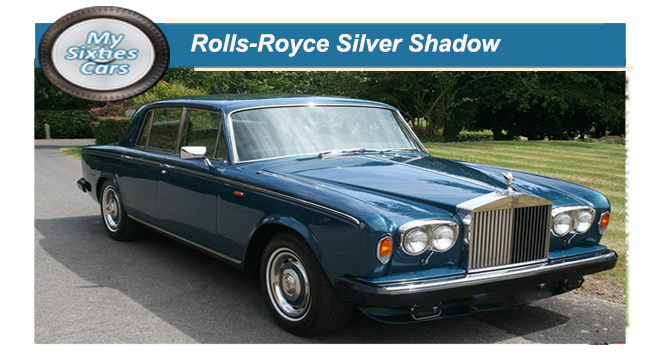
The model that heraled Rolls-Royce into the Sixties was undoubtedly the Silver Shadow- introduced in October of 1965,
The Silver Shadow had been in development for a considerable time and when this signature model appeared it marked a major breakthrough in design and technology in keeping with the times.
Despite its many modern features, not everyone applauded the next Rolls-Royce generation when it first appeared. Some criticised the Shadow for its differences from the past, breaking with tradition.
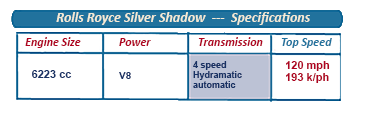
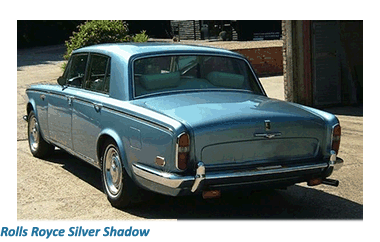 To begin with, the new model no longer employed the traditional chassis beloved of custom coachbuilders, signalling the beginning of the end for the conventional custom bodies on Rolls-Royces, along with the perception that Rolls-Royces had moved from being classical in design to just old fashioned.
To begin with, the new model no longer employed the traditional chassis beloved of custom coachbuilders, signalling the beginning of the end for the conventional custom bodies on Rolls-Royces, along with the perception that Rolls-Royces had moved from being classical in design to just old fashioned.
The Rolls-Royce Silver Shadow was powered by a 6.2-litre aluminium engine, which had proved itself well on the Silver Cloud.
The 6.2 engine was coupled to an improved four-speed automatic gearbox.
The Silver Shadow’s suspension consisted of independent springing on all four wheels and four-wheel disc brakes to ensure smooth and effortless stopping power, even from the Silver Shadow's impressive top speed.
Dual-circuit braking and self-levelling suspension were fitted as standard, ensuring the first-class ride quality that had traditionally been associated with driving (or being driven) in a Rolls Royce.
![]()
As owners had come to expect from a Rolls Royce, the Silver Shadow’s interior was modestly palatial with the top quality hide upholstery and real wood panelling.
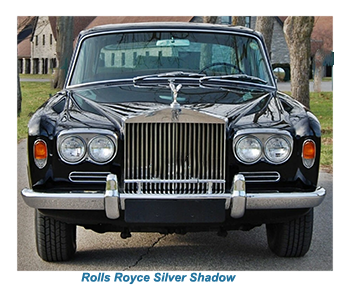
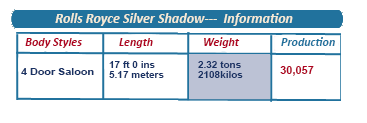 In a tribute to the "swinging Sixties, the Silver Shadow was available in a choice of fourteen bodywork colours, with two tones now approved when once they were frowned upon.
In a tribute to the "swinging Sixties, the Silver Shadow was available in a choice of fourteen bodywork colours, with two tones now approved when once they were frowned upon.
The new Silver Shadow received a mixed response, loved by the motoring press and by those who put aesthetics and engineering sophistication before the status-symbol appearance and dignified antiquity.
In particular, the changed proportions of the traditional radiator, which was now considerably more shallow than hitherto, brought broadsides from the 'old brigade.'
To meet the demands of those who wanted the best of both worlds – a modern Rolls Royce but in a limousine format was granted their wish in 1969 when Rolls Royce launched a long-wheelbase variant, some of them even coming with an internal glass divider, like in the good old days.
Also available, but by special order only, was a two-door fixed-head coupe which could be produced by either MuIinner Park Ward or James Young, with the latter much scarcer.
![]()
Also as a result of increasing demand, a convertible version of the Silver Shadow was released in 1967 to tremendous success.
The Silver Shadow Softop proved to be such a winner that in 1971, it became a model in its right, marketed as the Corniche.
As the end of the Sixties approached, Rolls Royce introduced a coupe version of the Silver Shadow, custom designed by Pininfarina and built on the Shadow's platform.
T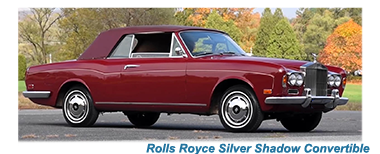 he “Shadow coupe “ was marketed as the Camargue, going on to earn the historical distinction of being the most expensive Roller produced during the Twentieth Century, with a higher price ticket than even the Phantom VI limousine.
he “Shadow coupe “ was marketed as the Camargue, going on to earn the historical distinction of being the most expensive Roller produced during the Twentieth Century, with a higher price ticket than even the Phantom VI limousine.
The Silver Shadow remained in production until the end of the Seventies, in the process becoming the best selling “Roller in history.
The “Shadow’s” spinoffs, the Corniches and Camargues comfortably outlived their parent, with the last models still being produced in the late Eighties.






